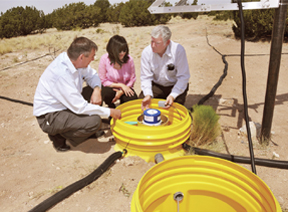
Most Sandians will never find themselves anywhere near the Facility for Acceptance, Calibration, and Testing (FACT). The facility sits far southeast of the tech areas, down several winding dirt roads. Researchers at the remote site prefer their neighborhood quiet.
The site provides testing facilities for researchers to evaluate geophysical sensor systems of all types, but primarily seismometers and infrasound sensors (for very low-frequency sound). These sensors are the most useful for detecting nuclear explosions hidden underground or near the surface. Signals from these large events can travel thousands of miles through the Earth or the atmosphere until they are picked up by a monitoring station.
Expanding its footprint
Generally, sensor system experiments usually involve laying out sensors, creating signals that are recorded by the instrumentation, and then analyzing the recorded data. Seismic equipment doesn’t respond well to above-ground noise, so the facility has underground spaces and boreholes where the only vibrations the sensors pick up will be the vibrations from their tests.
Soon, FACT will expand its footprint from 40 acres to 400 acres to provide more testing space and more buffering space between its facilities and other projects.
“There are lots of different types of seismic work,” says Sandia principal investigator Darren Hart (5736). “Nuclear test monitoring sensors, unattended sensors, tunnel sensors. After all, explosions are explosions.”
Some sensors tested at the site can be used to monitor seismic activity related to natural geophysical events both underground and above ground. Other systems tested there will be installed at locations all over the world to alert in the event of unexpected underground nuclear tests. The sensor systems also vary in their range from “near field” sensors that monitor things nearby to those that monitor things hundreds to thousands of miles away.
“Some sensor work involves distinguishing man-made seismic events from naturally occurring events such as earthquakes,” Darren says. Researchers need to know how to distinguish nuclear detonations from large explosions for industrial purposes such as mining and from earthquakes. “Earthquake signals start small and grow larger,” Darren says. “Mining or other explosions create big bangs that get smaller over time. Their profiles are different.”
Studying proliferation detection
Most of the Sandia researchers at the site study proliferation detection. They evaluate ways to improve our ability to monitor the Earth for underground nuclear detonations. One way researchers decide how to look for underground nuclear tests is by doing mantle and core simulations. Researchers attempt to discover what would happen to signals as they pass through the Earth’s mantle and core and what they would look like in the event of a test.
Mark Harris (5736), FACT site manager, says engineers at the site test components that go into sensor systems for US monitoring systems deployed by the Air Force. Other researchers develop and test seismic sensor systems that get deployed around the world for the United Nations’ Comprehensive Nuclear Test Ban Treaty (CTBT) detection systems at International Monitoring System (IMS) sites.
Mark says that nations that participate in the CTBT would want to know if anyone attempts any nuclear test. Sensor systems such as those developed at Sandia allow CTBT participants to be confident that unexpected tests can be detected and analyzed.
Two years ago, North Korea surprised the world by attempting a full-scale nuclear test. Researchers wanted to know if the test was successful and precisely how successful it was. Sensor systems such as those tested at the site are one way to collect data on such activities.
In late October, the FACT site sponsors hosted the first Rio Grande Instrumentation and Testing Community Meeting. The event brought together seismic researchers from Sandia, United States Geological Survey, Los Alamos, New Mexico Tech, and many other organizations. Mark says that one goal of the meeting was to solicit collaborations with outside agencies to better meet future threats.
The workshop also included representatives from the Incorporated Research Institutions for Seismology (IRIS) Program for Array Seismic Studies of the Continental Lithosphere (PASSCAL) Instrumentation Center at New Mexico Tech. This consortium provides state-of-the art equipment for many different types of seismology research. Anyone can request to use PASSCAL equipment for scientific work, provided they allow the experiment data to be freely available two years after the completion of field work.
Ultimately, researchers at the FACT site hope that expanding the site and engaging sensor researchers in other communities will allow them to share best practices and to expand work done at the site. In the future FACT also hopes to reach out to Kirtland AFB testing groups so that explosive events on base could be used as data in sensor system tests. “It would be nice to analyze the activity on base,” Darren says, “so that we can compare our analysis of FACT data to the activities taking place during the tests.”